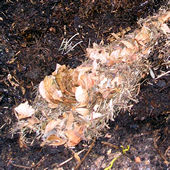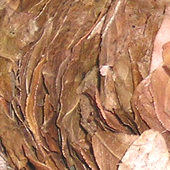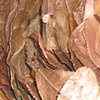Quiet as a . . . .
I have to mention, though I hope my neighbours aren't listening (I'll have to whisper), that there are mice in my compost heap. These are though field mice (also known as wood mice), rather than house mouses.
I can't think about the mice without thinking of a) the film The Green Mile and b) that little song about the mouse . . . "Where?! - There on the stair - Where on the stair?! - Right there! - A little mouse with clogs on! Well I declare!" -etc. I guarantee that if you know that song and now have it in your mind, you'll find it impossible not to feel a bit jollier than you did before. (It's also likely that now I've put it into your mind it will take at least a day for you to get it out of your mind, for which I apologise.)
Anyway, I haven't seen any mice on the stairs, or indeed anywhere else in the house, so that's good. (The evidence suggests that Rosie and other cats are keeping numbers down, so I'm hoping it won't be like that windmill in Amsterdam in the song.) The field mice do seem to like our shed, but I don't mind as long as they keep themselves to themselves, and preferably in corners, quietly.
Tunnels in the compost heap
When I investigate the compost heap, I expect to find them in there. They make tunnels through the heap, and create sleeping chambers. When I recently emptied the compost heap that had been left undisturbed since last year, I guessed that I might encounter a mouse. Indeed, on moving through the compost I found one end of a tunnel - a hole that was obviously too big for a worm - and suddenly there was this movement through the heap and a nose stuck out from another part of the heap - presumably the other end of the tunnel. I could see whiskers, and blinking eyes, presumably from a mouse that had been suddenly woken up and was trying to get its bearings. Rather like me in the morning before I've had a cup of tea (not the whiskers bit though).
You can't be upset by a mouse when it's still, and looking about, and a bit scared. This one spent some time where it was, twitching its nose, presumably wondering if I was friend or foe, then it ran off into the ivy. But not before doing some rather endearing attempts to scale the post at the corner of the heap, in an impressively acrobatic way.
Cosy home
I had to continue clearing the rotted-down compost from the heap, so after retreating for a cup of tea, to allow any other creatures to disappear out of the way, I carried on, and discovered, right in the middle, a perfect little nest made of dried grass and dried leaves. I felt bad that I had to destroy such a carefully-made thing. The leaves had been layered thickly one on top of the other, presumably providing insulation against even the worst winter weather. It looked warmer than our house. Every type of leaf was in there - the beech leaves that blow into our garden from hedges way up the street, the Choisya ternata leaves that are found dried-up and brown under the shrub's branches.
When I'd taken out all the useable compost I replaced in the compost enclosure all the material that had been on the top that hadn't rotted down yet. But I gathered up the mouse's fine creation and put it all in a plastic plantpot, placed back down the side of the compost heap. Materials may, I thought, be reused in a remodelled mouse nest. Possibly, if the mice have seen the BBC's Changing Rooms, they'll be happy with my redesigned "nest in a plastic plantpot" idea, and just spray a couple of the leaves purple and bring in a bit of MDF.
Apologies for not getting a photo of the mouse(s), only the nest. I can state though, for the record, that it didn't have clogs on.

Above: the disturbed mouse nest.
Below: detail from the mouse nest - an impressive dwelling, which we humans could probably learn from. Clever use of available materials, and no MDF.


